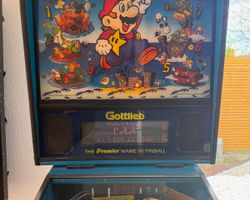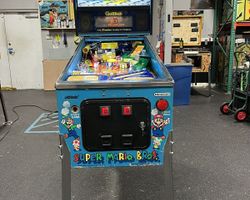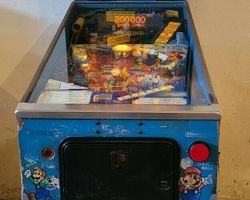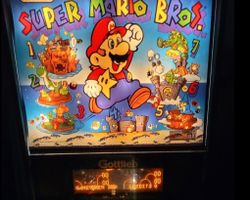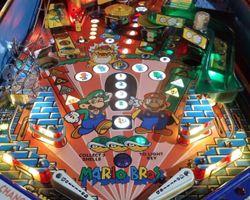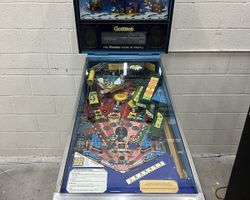Super Mario Bros.
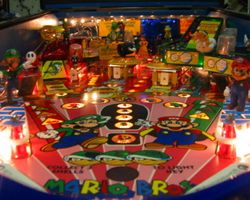
Average Prices: USD $500 to $2,500
Produced: April, 1992
Production Run: 4,200 units
Machine Type: Solid State Electronic
MPU: Gottlieb System 3
Players: 4
Concept by: Nintendo
Design by: Jon Norris
Art by: Constantino Mitchell, David Moore, Jeanine Mitchell
Dots/Animation by: Daryl Moore, Rand Paulin
Software by: Allen Edwall, Rand Paulin
Premier Technology, operating under the esteemed Gottlieb banner, brought one of the most recognizable video game characters to the pinball world in April 1992 with Super Mario Bros. Leveraging the immense popularity of Nintendo's flagship franchise, this machine aimed to capture the magic of the Mushroom Kingdom in a kinetic, silverball format. As Gottlieb's first title featuring a Dot Matrix Display (DMD), it marked a significant step for the manufacturer, blending a globally beloved theme with emerging pinball technology.
History and Background
By the early 1990s, the Super Mario phenomenon was undeniable. Nintendo's plumber had become a cultural cornerstone, making the leap to pinball a logical, albeit ambitious, undertaking. D. Gottlieb & Co., operating as Premier Technology during this period, secured the license, recognizing the immense potential of bringing Mario, Luigi, Bowser, and Princess Peach to the arcade floor.
The project, model number 733, was built on the Gottlieb System 3 platform. Development involved a dedicated team aiming to translate the video game's essence. Jon Norris headed the design, tasked with creating a playfield that felt both familiar to Mario fans and engaging for pinball players. The artistic direction was handled by Constantino Mitchell, David Moore, and Jeanine Mitchell, who worked to replicate the vibrant, cartoonish aesthetic of the Super Mario universe across the cabinet, backglass, and playfield.
Sound design was crucial for immersing players. Craig Beierwaltes handled the sound engineering, while Dave Zabriskie composed the music, incorporating familiar jingles and themes from the video games. Allen Edwall and Rand Paulin developed the software and animations, bringing the DMD to life with scenes and characters directly inspired by Nintendo's creation. Rand Paulin and Daryl Moore contributed specifically to the animation sequences. Nintendo itself is credited with the original concept, highlighting the collaborative nature of adapting such a well-known property.
Released on April 25th, 1992, Super Mario Bros. saw a substantial production run of 4,200 units. Its arrival was heralded by marketing slogans like "The Hit Video Game Comes to Pinball!!!" and "Mario Mania Comes to Pinball!!!". Its introduction of the DMD was a notable milestone for Gottlieb, allowing for more complex scoring displays, animations, and mode indicators compared to previous alphanumeric displays. This technological advancement, combined with the powerful theme, ensured the machine garnered significant attention upon release. An interesting feature integrated into the design was a unique drop target situated between the flippers, acting as a temporary ball save mechanism when raised – a helpful touch echoing the game's accessible nature.
Signature Features and Design
Super Mario Bros. pinball distinguishes itself through thematic integration and specific playfield toys. The most prominent feature is the elevated mini-playfield, representing different worlds or castles from the Mario universe. Accessed via Vertical Up-Kickers (VUKs), this upper level adds a vertical dimension to the gameplay and serves as a key area for achieving objectives.
Dominating the upper portion of the main playfield is the Revolving Castle toy. This motorized mechanism incorporates targets and plays a central role in game progression, often linked to defeating Bowser or completing world objectives. Its visual presence and interactive nature directly tie into the core Mario narrative of storming castles to rescue Princess Peach.
The machine utilizes three flippers: two in the traditional lower position and a third on the upper right side, facilitating shots on the elevated mini-playfield and controlling the ball's return to the main level. This configuration allows for distinct shot-making opportunities compared to standard two-flipper layouts.
The artwork package is a defining characteristic. Faithful to the source material, the cabinet, backglass, and playfield plastics are adorned with bright colors and familiar characters rendered in the classic Mario style. This strong visual identity immediately connects with fans of the video game and contributes significantly to the machine's overall appeal, particularly in family entertainment settings.
Playfield and Mechanics
The Super Mario Bros. playfield, designed by Jon Norris, attempts to translate the platforming adventure of the video game into a pinball experience. The layout features two primary ramps. The main, large plastic ramp on the left feeds the ball to the right upper flipper, enabling shots towards the mini-playfield or allowing the ball to return to the lower playfield. A second path, often considered a ramp shot, directs the ball towards one of the VUKs that launches it onto the elevated mini-playfield.
Key features include three pop bumpers clustered near the top, adding chaotic action when the ball enters that zone. A single bank of stand-up targets requires completion to advance certain modes or objectives. Two VUKs are strategically placed; one sends the ball to the upper playfield, while another might serve a different function, potentially related to locking balls for multiball or initiating modes.
The flow of the game encourages players to make specific shots to progress through the different "worlds." Ramps feed the upper playfield sections, where the third flipper comes into play. Shots are generally oriented towards the upper half of the playfield, focusing on the ramps, the castle toy, and the mini-playfield access points. The lower playfield features standard lane rollovers and slingshots, along with the unique pop-up drop target ball-saver between the flippers.
Aesthetically, the playfield is vibrant and busy, filled with depictions of Goombas, Koopa Troopas, Piranha Plants, and other Mushroom Kingdom inhabitants. Lighting is functional, highlighting key shots and modes, consistent with early 90s designs preceding the more complex light shows of later machines. The overall design philosophy leans towards accessibility, with relatively open shots to the main ramps and features, making it approachable for newer players while incorporating enough targets and objectives to maintain engagement. The automatic plunger launches the ball into play, starting the quest through the pinball version of Mario's world.
Gameplay Dynamics
Super Mario Bros. offers a straightforward, objective-based ruleset. Players progress through seven distinct "worlds," mirroring the structure of the video games. Completing shots and targets within each world advances the player towards a castle, culminating in a confrontation, often involving the Revolving Castle toy.
Scoring is generally tied to completing these worlds, hitting major shots like ramps and loops, and achieving multiball. The game features a 3-ball multiball mode, typically started after locking balls via specific shots, often involving the VUKs or castle mechanism. During multiball, scoring is usually increased, providing opportunities for high scores by repeatedly hitting jackpots associated with ramps or other key targets.
One of the most distinctive gameplay elements is the Video Mode. Activated under certain conditions, this mode appears on the DMD and requires players to use the flipper buttons to control Mario. Typically, the left flipper button makes Mario run faster, while the right flipper button makes him jump over obstacles and enemies, mimicking the side-scrolling action of the original game. Successfully completing the video mode awards bonus points or other advantages.
While not known for deep, complex strategies, gameplay often involves learning the most efficient ways to complete world objectives. This usually means repeatedly hitting the main ramps to access the upper playfield or focusing on the specific targets required for the current world. The rules are generally easy to understand: shoot the flashing lights to progress. The custom speech, featuring voice work reminiscent of Mario, calls out modes and achievements, enhancing the thematic immersion. The inclusion of familiar sound effects further ties the pinball experience to its video game roots.
Reception and Legacy
Upon release and throughout its lifespan, Super Mario Bros. pinball garnered a mixed but generally positive reception, particularly noted for its thematic execution and accessibility. Its greatest strength lies in the universally appealing Super Mario theme. The faithful artwork, recognizable sounds, and inclusion of Mario's voice created instant attraction, making it a popular choice for families, children, and casual players. The straightforward ruleset was frequently praised for being easy to grasp, allowing novice players to quickly understand objectives and enjoy the game. The fun factor, especially for shorter play sessions, and the nostalgic connection for Mario fans remain significant positives. Some also noted the machine's reliability, a practical advantage for operators.
However, these same aspects drew criticism from more experienced pinball players. The relatively simple rules and easy-to-achieve objectives led to complaints about repetitive gameplay and a lack of long-term depth or challenge. Seasoned players often found the game too easy, quickly mastering the main shots and modes. The audio package, while thematically appropriate, was cited by some as grating or repetitive over extended play, particularly the Mario callouts. Aspects of the playfield layout were occasionally questioned, and a common point of critique, often leveled at Gottlieb machines of this era, was the perceived weakness or lack of satisfying feedback from the flippers compared to competitors' offerings.
Despite these criticisms, Super Mario Bros. holds a distinct place in pinball history. It successfully demonstrated the power of a major licensed theme, attracting players who might not otherwise have approached a pinball machine. Its status as Gottlieb's first DMD game gives it technical significance. While not typically ranked among the top competitive machines due to its perceived lack of depth, its reputation endures as a fun, family-friendly title with strong nostalgic value. It remains a sought-after machine for collectors who appreciate the theme or seek a more accessible game for a diverse audience. Its existence underscored the potential for cross-media synergy between video games and pinball during a period of intense innovation for both industries.
 Active Auctions
Active Auctions
 Auction Results
Auction Results
| Cost | Location | Date |
|---|---|---|
| EUR €2,850 |  Bayern, Germany Bayern, Germany |
27 March, 2025 |
| USD $6,889 |  Florida, United States Florida, United States |
30 November, 2024 |
| USD $4,300 |  Wyoming, United States Wyoming, United States |
28 November, 2024 |
| AUD $4,208 |  Queensland, Australia Queensland, Australia |
16 March, 2024 |
| USD $8,500 |  California, United States California, United States |
04 March, 2024 |
| USD $4,100 |  Oklahoma, United States Oklahoma, United States |
05 December, 2023 |
| USD $12,100 |  Minnesota, United States Minnesota, United States |
05 August, 2023 |
| USD $4,850 |  Utah, United States Utah, United States |
06 January, 2023 |
| USD $5,300 |  Maryland, United States Maryland, United States |
14 October, 2022 |
| EUR €3,299 |  Hessen, Germany Hessen, Germany |
11 October, 2022 |


Private Policy · Search Website · Contact Us
All trademarks and copyrighted materials remain property of their respective owners.
All other content copyright 2007 - 2025 Pinpedia.

